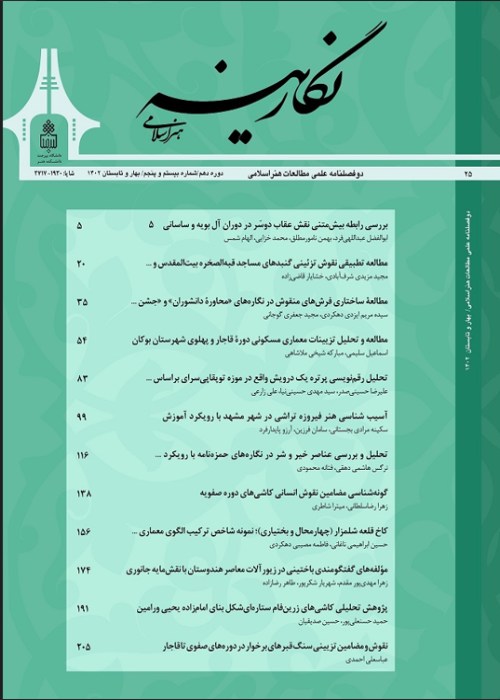The Conceptual Relationship Needlework Traditional Art on the Clothing of Sufis of Fotovvat and Sacred Words, Names, and Numbers
Author(s):
Article Type:
Research/Original Article (دارای رتبه معتبر)
Abstract:
The traditional art of needlework on Sufis’ clothes which was performed with stitches and patches could create new meanings in the type of clothing through variations in techniques and patterns. Fotovvat-naameh, which is a literary genre that addresses the manifestations of the Divine in different arts and crafts, provides a good medium for the interaction of artistic and mystic meanings. Historically there has been a close relationship between the followers of Fotovvat and Sufism. The present study investigates the patterns of needlework on Sufis’ clothes and their relationship to the artist’s beliefs as represented in Fotovvat-naamehs. Two questions will be addressed in the study: 1) What underlies the conceptual relationship between needlework patterns and Divine names as well as sacred numbers on Sufis’ clothes in the ethos of Fotovvat? 2) What is the method of needlework used on Sufis’ clothes? According to our findings, the needlework on Sufis’ clothes was created using geometric stitches called dervish-work and these clothes were known as Hezaarmikhi, Ghoreyshi, Taj-gharjagh, and Taj-e Hezaarmikhi. Hezaartoo stitches were used in Ghoreyshi, patchwork was used in Khergheh-ye Moragha’eh and Na’leins, and thick stitches as well as drawn thread were used in Maftooli Khergheh. In Khaksariyeh and Faghriyeh, two major treatises on Fotovvat, it is stated that needlework with patches and stitches on all types of clothing, along with religious rituals in the form of question and answers, is based on the ethical and mystic concepts derived from Islamic principles and the Quran. Needlework artisans were mystics who contemplated into the Divine realm and, by using geometric stitches and square patches, expressed God's remembrance through Elm-e Horoof [=Knowledge of Letters] and sacred numbers. Thus, they not only demonstrate their beliefs but also represent it as a kind of movement towards perfection. This study uses a qualitative approach along with description, observation, and library research.
Keywords:
Language:
Persian
Published:
Journal of Negarineh Islamic Art, Volume:7 Issue: 20, 2021
Pages:
137 to 150
https://magiran.com/p2316041
دانلود و مطالعه متن این مقاله با یکی از روشهای زیر امکان پذیر است:
اشتراک شخصی
با عضویت و پرداخت آنلاین حق اشتراک یکساله به مبلغ 1,390,000ريال میتوانید 70 عنوان مطلب دانلود کنید!
اشتراک سازمانی
به کتابخانه دانشگاه یا محل کار خود پیشنهاد کنید تا اشتراک سازمانی این پایگاه را برای دسترسی نامحدود همه کاربران به متن مطالب تهیه نمایند!
توجه!
- حق عضویت دریافتی صرف حمایت از نشریات عضو و نگهداری، تکمیل و توسعه مگیران میشود.
- پرداخت حق اشتراک و دانلود مقالات اجازه بازنشر آن در سایر رسانههای چاپی و دیجیتال را به کاربر نمیدهد.
In order to view content subscription is required
Personal subscription
Subscribe magiran.com for 70 € euros via PayPal and download 70 articles during a year.
Organization subscription
Please contact us to subscribe your university or library for unlimited access!


